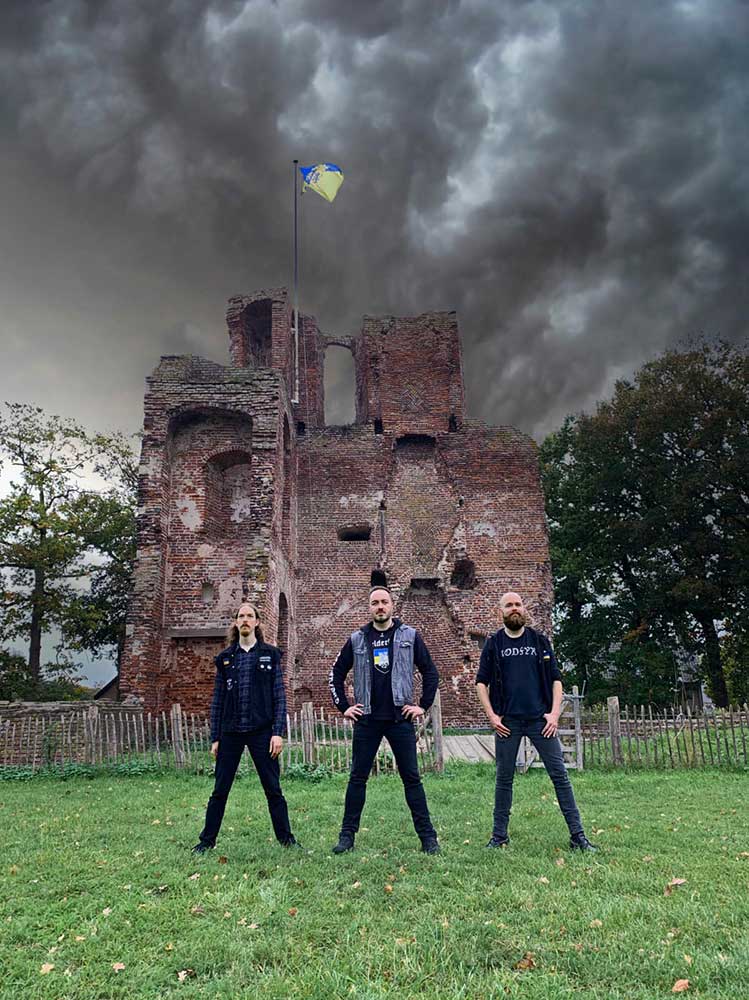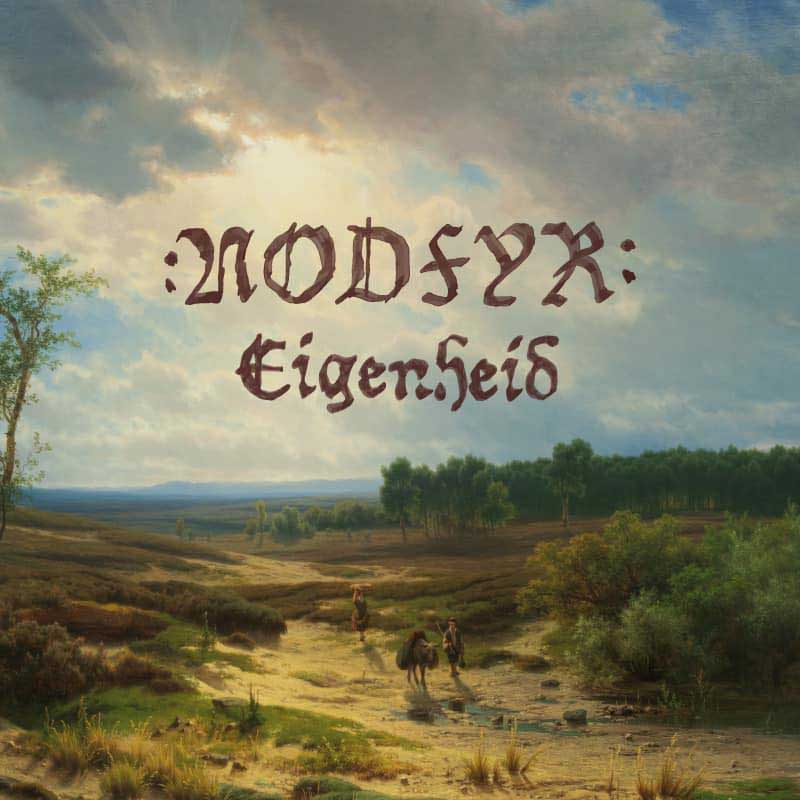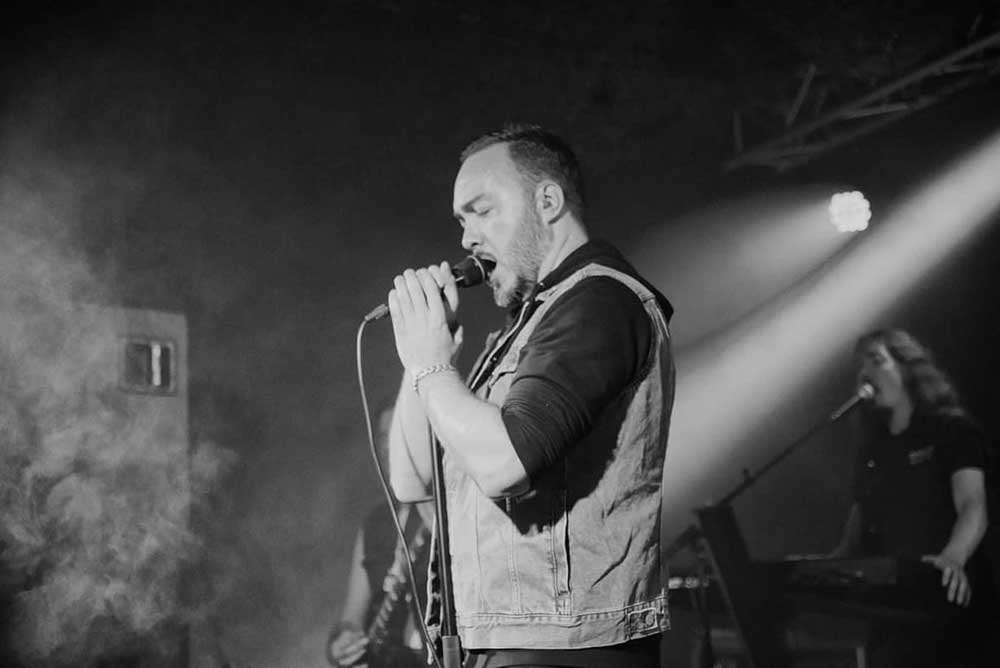:NODFYR:
2021-03-31
by Niklas Göransson
Heathen metal from Gelderland – :NODFYR: is a cleansing by fire, as well as the torch revealing pathways out from the ashes. Co-founder and frontman Joris speaks of burning the old to rekindle the present.
– Our debut is a concept album through which we explore several elements that have shaped and defined who we are. “Eigenheid”, which translates to ‘characteristic’, or ‘trait’, is the result of three years of introspection and song-writing, during which we explored local history, environments, and folklore – as well as our own psyches. It resulted in seven songs, each of which pays tribute to one pillar of our identity.
“Eigenheid” was released by Ván Records in March 2021, ten years after the formation of :NODFYR:. The music is difficult to categorise; despite the complete lack of harsh vocals, it has an atmosphere strongly reminiscent of mid-90s pagan and nature oriented black metal. Some parts resemble Fenriz and Satyr’s collaborative project STORM whereas others remind me of “Filosofem”. Listening to Joris’ baritone voice, it occurred to me that I’m not aware of any other contemporary genre – meaning, disregarding opera, musicals, folk, etcetera – than metal which incorporates this style of singing.
– Not that I know of! There are plenty of bands in various modern genres incorporating samples of such vocals, but I can’t think of any that make steady use of it. I believe this folkish, solemn, and proud type of singing fits heathen themes extremely well, so it makes sense that bands with such a vibe became synonymous with it. However, I suspect the origins of this go a bit deeper than pagan-era BATHORY and 90s black metal – back to the likes of ROOT and CANDLEMASS – but it’s hard to recreate the exact pedigree, so we’ll never fully know who was influenced by whom. In my case, I cannot leave Cornelis Vreeswijk unmentioned here; I’m sure you’re familiar with him in Sweden!

:NODFYR: themselves use the terms ‘heathen metal’ and ‘epic metal’ to describe their music, but I wouldn’t be surprised if some people labelled this ‘folk metal’ – a subgenre popularised around the millennium shift by bands such as FINNTROLL and ENSIFERUM. By virtue of a decade as frontman for HEIDEVOLK, I’m assuming Joris is very familiar with this scene.
– I left that world behind in 2013. I was feeling increasingly out of place after witnessing so many bands that were either insincere from the start or slowly abandoning their principles. Sadly, terms like folk and pagan metal have become tainted, because most who label themselves thus seem to have no understanding for how to treat these subjects with dignity and respect. I’ve seen more tackiness, decadence, prima-donna behaviour, and dishonesty than I care to remember. In the end, I came to the conclusion that this was basically a rock ‘n’ roll scene with a pagan façade, and I had drifted further along with it than I should have. I was disappointed in the movement, but also in myself; I had slowly turned into a circus bear!
HEIDEVOLK appears to have enjoyed a reasonable amount of success at one point. Regardless of later developments, this sounds like an interesting life experience to have; being part from the very beginning of a band that kept going for several years – even self-releasing their debut album – before breaking through.
– Yes, I had a great time. I could put so much energy and inspiration into the project – it was highly rewarding to build something from the ground up and then witnessing it grow. We were able to reach so many people with our work, and I’m very proud to know it meant a lot to so many. I received messages from fans telling me our music helped them maintain their fighting spirit during chemotherapy, how certain songs helped them cope with a loss, or that they met their future wife at a show. It wasn’t something we set out to do, but there was a gradual realisation that people were really getting something out of our efforts; I consider this our greatest achievement. Even after our once proud drakkar had started morphing into a bit of a party cruise, I’m still proud of what we accomplished together and grateful to the guys I worked with back then.
I read an old HEIDEVOLK interview on The Norse Mythology Blog – conducted during a 2013 US tour, shortly before Joris’ departure. He described himself as a ‘hardliner’ in terms of not compromising with the lyrical themes. ‘It’s important that we have a message, that it shouldn’t become a shallow image or anything.’ He also implied an internal rift of sorts in terms of how seriously the subject matter was taken.
– The problem was basically me not dealing too well with the fact that both our band and the scene at large were heading in a direction which didn’t suit me at all. I tried steering things towards a course I thought was better. I kept getting increasingly frustrated that the six of us were unable to come together under one clear vision, either musically or conceptually. This didn’t make me a very nice person to be around. Luckily, I somewhat managed to return to my old self after leaving; it was definitely the right decision. We don’t meet each other that often anymore but I’m still on friendly terms with everyone. Once in a while, I organise a reunion dinner where we catch up on old stories and have a drink for old time’s sake. I recently helped them out with a streaming show, so we’re cool.
Before speaking with Joris, I had a look online and swiftly concluded that interest for this scene seems to have plummeted over the past decade since he left.
– I haven’t really kept track… but if you’re right, I jumped ship at the right time, haha! I’m not sure the scene has collapsed entirely though, and I think a lot of people will want to see these kinds of shows again once the pandemic is under control. Especially after binge-watching Vikings on Netflix and finishing Assassin’s Creed Valhalla. Meanwhile, I have grown a bit milder in my judgement. While I do think that there should be a balance between the solemn and the jolliness, as well as the spiritual and the profane, I’ve come to accept that these larger festivals and tours are about one thing only: entertainment. People don’t show up to hear a pagan prayer, but to take part in a pagan party – it is what it is. The only thing you can do is set the right example and try not to get corrupted; SKYFORGER being the perfect example. Of course, I’d much rather see these venues filled up by people with a genuine interest in the subject matter, who’ve come to watch authentic artists perform. But even though a lot of it is plastic, tasteless, and obnoxious, I’d much rather see people going to shows like these than to other manifestations less rooted in history and folklore.

I’m curious about the experience of reverting back to far smaller bands after fronting one of this magnitude. Taking touring as an example; when one is used to a certain standard, I imagine going back to a stage one has already passed must be a bitter pill to swallow.
– To be honest, I miss neither the bigger stages nor the many perks of being higher on the bill. At all. Of course, it’s cool to see a huge audience going insane during your show and then having a comfy backstage to relax in afterwards, but it simply wasn’t worth sacrificing my integrity for these things. I’d much rather play an intimate setting in front of a smaller audience that’s not just about partying. What I do miss is all the traveling, as well as the excitement of performing in new territories. Reaching new people, and so forth. Hopefully, that’s what is in the cards for :NODFYR:. But for the time being, I have all the success I could dream of. A band consisting of talented friends who all share one vision. A new record we’re proud of. An amazing label named Ván run by a great guy named Sven. An interview by a ‘zine I really admire. I’m a happy man. This was also one of the biggest motivations for founding :NODFYR: ten years ago. I felt an urge to start at the bottom, with a clean sheet, and create something pure: music that lies as close to my heart and mind as possible. And that’s why I chose the word ‘nodfyr’ as a moniker.
‘Nodfyr’ is Proto-Germanic for what we know today as ‘need-fire’ – an ancient practice among shepherding communities all over Europe.
– For many years now, I’ve been interested in sources which document pagan traditions in our region. I stumbled across the word ‘nodfyr’ in the Indiculus superstitionem et paganiarum: an 8th-century index of Frisian and Saxon practices prohibited by the church. Sadly, it does not reveal any details, but there are many folkloric examples of rituals where – following great turmoil – an old fire is extinguished and a new one lit to bring back prosperity. It wasn’t necessarily borne out of an acute crisis, but rather to avoid one in the making. All this is well-described in Frazer’s The Golden Bough.
First published in 1890, The Golden Bough: A Study in Magic and Religion is an ambitious and widely influential comparative study of European religion and mythology by Scottish anthropologist Sir James George Frazer. One of many customs he examined was the fire festivals – the need-fire, sometimes called ‘wild fire’, or ‘living fire’ among Slavonic people. As with many pre-Christian rituals, the clergy did their best to stamp out the lingering pagan superstition. Despite this, the need-fire was still practised both in the British Isles and Germany halfway through the 1800s. It was resorted to in times of looming disaster, mostly as a means of warding off epidemic livestock diseases such as murrain. Many variations evolved in different geographical regions, but there are a few common denominators. In most places it was imperative that the fire be kindled by the friction from two pieces of wood being rubbed together, as opposed to flint and steel. Oak seems to have been favoured in Germanic countries, whereas the Slavs used cornel, pear, or poplar wood. If a string was part of the incendiary arrangement, it was preferable to use one woven from strands of gallows rope. Another recurring rule was that all other sources of illumination in the vicinity had to be extinguished. If the need-fire would not burn, the first course of action was to search nearby homes for hearths left smouldering. With the flame lit, the bonfire was set ablaze and left to burn down. Once reduced to cinders, the animals in want of protection – pigs, cows, or horses, mostly – were driven through the still-glowing ashes. Once the animals had been cleansed, villagers would commonly bring along live embers back home to rekindle their own fires. The ashes were believed to have special properties; they were dispersed over the soil to shield crops from pests or mixed with water and drunk to cure human ailments.
– Even though we use contemporary means to create and spread our music, the :NODFYR: concept is based on inspiration drawn from nature, history, folklore, and mythology. It’s tragic to see how much heritage is lost because people are too indifferent, or even actively discouraged from caring about it. We appreciate the beauty of our region and its traditions; that’s what we stand for. It is the manner through which we manifest ourselves. :NODFYR: is a modern tool for the renaissance of archaic values, but also classical music and even heavy metal. I know this might sound a bit pretentious, but these timeless motives and art-forms are what inspire us. This is a passion that goes all the way back to my childhood. I grew up in a little village in a region called the Betuwe – probably from ‘bataz’, good, and ‘awjō’, island. At the time, we were about to be annexed by the city of Nijmegen, which lies to the south across the river Waal. Not all the villagers were fond of this idea, and it gave rise to a protest movement drawing on metaphors from the Batavian revolt.

When the Romans entered the region of Batavia, in what we today call the Netherlands, they found that a Germanic tribe had already settled there – the Batavi. I noticed that there are, in fact, two documented Batavian revolts – the 1st-century Revolt of the Batavi and then the Batavian Revolution of the 1700s. One gets the impression that these people are, or at least were, a quarrelsome kind.
– The first revolt against the Roman invaders back in 69 to 70 AD was the real deal! Subsequently, I drew some parallels from this to the village struggles of my childhood hero, Asterix, and started getting interested in local history. The story of the Batavians was very inspiring during the later formation of the Dutch nation, so people have often identified with them in later centuries. The Dutch have seen their fair share of conflicts over trade and territory – both in Europe and the rest of the world – and recent events have shown us to be more than willing to fight among ourselves. Another thing I remember from that time was the village pastor coming to our school and telling us how silly the people who used to live here were for believing in gods like Wodan and Donar.
Donar is the god of lightning and storms, prevalent all throughout recorded Germanic history; he’s commonly known these days by his Scandinavian form, Thor. It is believed all variations of his name derive from the Proto-Germanic word Þunraz, which means ‘’thunder’. Wodan is also primarily recognised under his Norse guise: Odin. The etymological root has been traced to Wōđanaz – interpreted as ‘leader of the possessed’ or ‘lord of frenzy’ – and speaks to his role as god of the battle-trance, as practised by berserkers and their ilk. Odinic warrior cults, referred to as männerbund today, were discussed extensively in my conversation with Dan Capp of WOLCENSMEN.
– The pastor’s speech probably didn’t have the effect he intended, as my interest in these gods was now fully awakened. I’d only heard these names a couple of times before, but then I discovered all the great stories about them. They appealed to me infinitely more than Jesus and the Christian god. When my parents sent me to school in Nijmegen I got acquainted with heavier forms of music, starting with SLAYER. All these influences eventually converged to carve out the musical and conceptual path I later continued here in the Veluwe region, where I still dwell today. It’s essential to know about the past and appreciate the worth and beauty of the achievements of your ancestors; it grants you an understanding of your own place in the world. And, seeing as how this is neither taught in schools nor handed to you by your surroundings, it takes time and effort to educate yourself and pass it on. Sadly, we seem to live in a time of social atomism where cohesion and connection to the past are lost. Most people are content with consuming and copying instead of conserving and creating. Yet I’m not pessimistic, because I believe the right people will eventually rediscover what is truly important and valuable.



